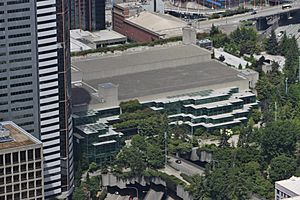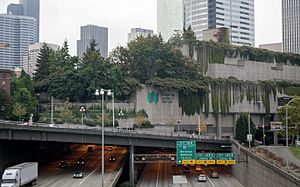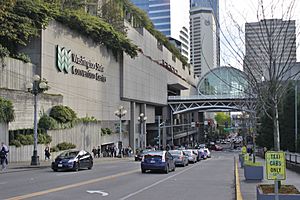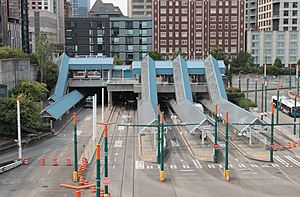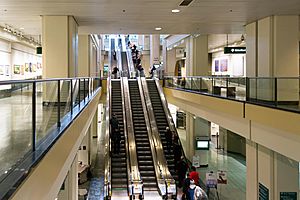Washington State Convention Center facts for kids
Quick facts for kids Washington State Convention Center |
|
|---|---|
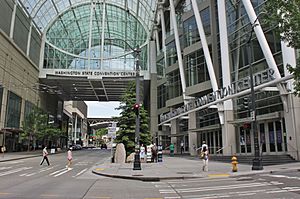
The convention center's entrance and skybridge, seen from Pike Street and 7th Avenue
|
|
| Address | 705 Pike Street |
| Location | Seattle, Washington, U.S. |
| Coordinates | 47°36′43″N 122°19′53″W / 47.61194°N 122.33139°W |
| Owner | Washington State Convention Center Public Facilities District |
| Built | 1985–1988 |
| Opened | June 18, 1988 |
| Expanded | 2001 |
|
Former names
|
Washington State Convention and Trade Center (1988–2010) |
| Enclosed space | |
| • Total space | 414,722 square feet (38,529 m2) |
| • Exhibit hall floor | 236,700 square feet (21,990 m2) |
| • Breakout/meeting | 123,761 square feet (11,498 m2) |
| • Ballroom | 44,628 square feet (4,146 m2) |
| Parking | 1,490 stalls |
| Public transit access | |
The Washington State Convention Center (WSCC) is a huge building in Seattle, Washington, United States. It's a place where big events, like shows and meetings, happen. The center has many halls and rooms for different activities. A cool part of the building is that it sits right over Interstate 5, a busy highway! It also connects to Freeway Park.
People started planning this center in the late 1970s. The state government helped pay for it with special money called bonds. Building started in September 1985, and the center first opened its doors on June 18, 1988.
Later, the center got much bigger! A major expansion happened from 1999 to 2001, which doubled the space for events. They even added a hotel and office tower. A special bridge, called a skybridge, was built over Pike Street to connect the old and new parts. Another big expansion began in 2018 and is expected to open in 2022.
Some of the biggest yearly events held here include PAX West (a gaming event), Emerald City Comic Con (a comic book convention), Sakura-Con (an anime convention), and the Northwest Flower and Garden Show. The center has about 415,000 square feet (38,600 m2) of space you can use. This includes two main halls for shows, which together are about 237,000 square feet (22,000 m2) big. The convention center is close to many hotels, shops, and public transport like the Westlake transit station.
Contents
History of the Convention Center
Why Seattle Needed a Convention Center
For a long time, Seattle used places like sports arenas, hotels, and theaters for big meetings and shows. The Exhibition Hall at the Seattle Center was built for the 1962 World's Fair. After the fair, it was used for conventions. In 1969, Seattle hosted its biggest meeting ever for the Shriners, which took place at the Seattle Center Coliseum.
In the 1970s, the state government thought a new, special convention center would help Seattle's economy. Different ideas for where to build it came up. Some thought about the Seattle Center, others looked at places downtown. A study in 1977 suggested a center with lots of meeting and exhibition space for up to 7,000 people. It would cost about $47 million.
In 1978, local leaders decided the best spot was where a bus base was located. They asked the state government to help pay for it. After some delays, the state government finally agreed in 1982 to provide $99 million for the project. This money came from special bonds that would be paid back using a tax on hotel stays.
Choosing the Best Location
In 1981, a special committee looked at new places for the convention center. They chose a design that would go over Interstate 5 near Freeway Park. Even though this spot was harder to build on and cost more, it was closer to downtown hotels and shops.
In 1982, a group was formed to manage the building and running of the center. They hoped to open it by 1986. Architects showed off their first designs in 1983. The freeway site was chosen because it could help bring new life to downtown. The city government agreed to help with the plans.
Building Challenges and Opening Day
The design for the convention center was updated in July 1983. It would have 140,000 square feet (13,000 m2) of exhibition space. The plan also included selling space above the freeway for private buildings. There were some worries from local residents about how the project would affect their neighborhood.
A big challenge came in December 1984 when the private company helping to fund the project ran into money problems. This caused delays and made it harder to get the project going. The state government had to step in and help secure the funding.
Finally, construction started on September 17, 1985. During this time, parts of Interstate 5 had to be closed or made smaller at night and on weekends. Building the foundation began in January 1986. Huge steel beams were put in place over the freeway, using a giant crane. This part of the project used a lot of steel, more than a 76-story skyscraper!
The Washington State Convention and Trade Center held its first event on June 18, 1988. It was officially opened by the Governor and Mayor a few days later. The center had 152,000 square feet (14,100 m2) of usable space, making it one of the largest in the U.S. at the time. It cost $186 million to build.
First Big Expansion
The convention center was very popular in its first five years. People believed it helped make Downtown Seattle a better place. So, plans for a big expansion began in 1994. The idea was to add a six-story building across Pike Street. This new part would add 144,000 square feet (13,400 m2) of exhibition space.
A key part of this expansion was a cool arched glass bridge, or skybridge, over Pike Street. This bridge would connect the two parts of the convention center on the fourth floor. Some people worried it would block views, but the design was approved.
Construction for this $205 million expansion started on May 19, 1999. The expanded convention center opened on July 14, 2001. With this, the total exhibition space doubled! In 2010, the center changed its name to the Washington State Convention Center, dropping the word "Trade."
Second Big Expansion: Summit and Arch
In 2008, plans for a second major expansion were proposed. The goal was to double the exhibition space again with a new building. This new building would be on the site of the Convention Place transit station, which was a bus and train stop.
The plan grew to include more blocks north of the station. The new building will have a huge exhibition hall, meeting spaces, shops, a ballroom, and a rooftop garden. It will also have parking. This project is expected to cost about $1.4 billion.
The Convention Place station closed on July 21, 2018, and was torn down. On August 14, 2018, construction began for the new expansion. The new building will be called "Summit," and the original convention center will be renamed "Arch." The expanded center is set to open in 2022.
Where is the Convention Center?
The convention center is located on Pike Street in Downtown Seattle. It stretches over Interstate 5, from Union Street to Pine Street. It's right next to many downtown hotels and shopping areas like Westlake Center and Pacific Place. You can easily get there by bus or by Link light rail to Westlake station.
What's Inside?
The convention center is six stories tall and has 414,722 square feet (38,529 m2) of space for events. The main public area is a four-story atrium. This is a large, open space with restaurants, shops, and cool public artwork. Each floor has a lobby, and two of them open right onto the street.
The center has 236,700 square feet (21,990 m2) of exhibition space on the fourth floor. This space is split into two halls that are connected by a 90-foot-wide (27 m) skybridge over Pike Street. This area can hold 1,105 booths for trade shows or 8,000 people for big meetings. There are also ramps for trucks and 23 loading docks.
The convention center has 68 meeting rooms, mostly on the second, third, and sixth floors. These rooms offer 123,761 square feet (11,498 m2) of space. The second and third floors also have parking garages with 1,490 spots. On the sixth floor, you'll find the kitchen and four ballrooms with 44,628 square feet (4,146 m2) of space.
Cool Design and Art
The convention center's design is special because it sits over twelve lanes of Interstate 5. It uses 30 concrete columns and strong foundations that go 100 feet (30 m) underground. The building is 800 feet (240 m) wide and covers an area as big as twelve city blocks! The concrete ceiling over the freeway is built to withstand high-temperature fires for up to eight hours.
The building's design is known for being unique. It has landscaped terraces with plants and trees that help it blend in with Freeway Park. Inside, the lobbies and atrium also have small trees, shrubs, and flowers. The south wall has cool green glass cubes that reach the ceiling.
The center also has amazing public art. One sculpture, Seattle George Monument, is 28-foot (8.5 m) tall and changes between the shapes of George Washington and Chief Seattle. The Centennial Bell Garden has 39 bells from every county in Washington. And Jenny Holzer's Truism, Living and Survival uses electronic signs to show phrases in different languages.
The convention center started its own arts program in 1997. They work with the Washington State Arts Commission to choose and display art. The second floor of the atrium, called the Phyllis Lamphere Gallery, shows art by local artists, and the displays change often.
Who Runs the Center?
The Washington State Convention Center is run by a special group called a public facilities district. This group has nine members chosen by the City of Seattle, King County, and the Governor of Washington. The center gets most of its money from a tax on hotel stays. In 2016, the convention center helped bring in about $348 million to the local economy from visitors' spending.
What Events Happen Here?
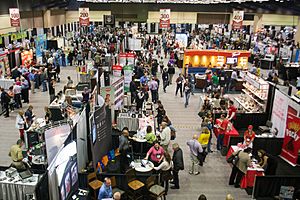
In 2016, the convention center hosted 335 events with over 397,000 people attending. About 50 of these were big national or international events. The center is so popular that it often has to turn away events because it's already booked!
Many large yearly events bring over 10,000 people. These include:
- PAX West: A huge gaming event every September. In 2011, over 70,000 people came!
- Emerald City Comic Con: A popular comic book convention. In 2017, 90,000 people attended.
- Sakura-Con: An anime convention that had 18,000 attendees in 2013.
- Northwest Flower and Garden Show: The center's biggest trade show, attracting 60,000 visitors.
- Microsoft's Build developer conference: This event started in 2017 and brings about 6,000 people.
The 1999 WTO Conference
The convention center was chosen to host the 1999 conference for the World Trade Organization. This was a very important meeting with thousands of delegates and journalists. Important leaders like President Bill Clinton were expected to attend.
However, the first days of the conference were interrupted by large protests. These protests blocked access to the convention center. The trade talks eventually failed. Even with the protests, the convention center's normal operations weren't greatly affected.
Impact of the 2020 COVID-19 Pandemic
In March 2020, over ten major events at the convention center were canceled. This happened because of the COVID-19 pandemic and rules against large public gatherings. Events like Emerald City Comic Con and Sakura-Con were either moved or completely canceled. This also meant fewer shifts for workers and a drop in hotel bookings. Many other big events, including PAX, were also canceled, leaving the center without conventions for a long time.


